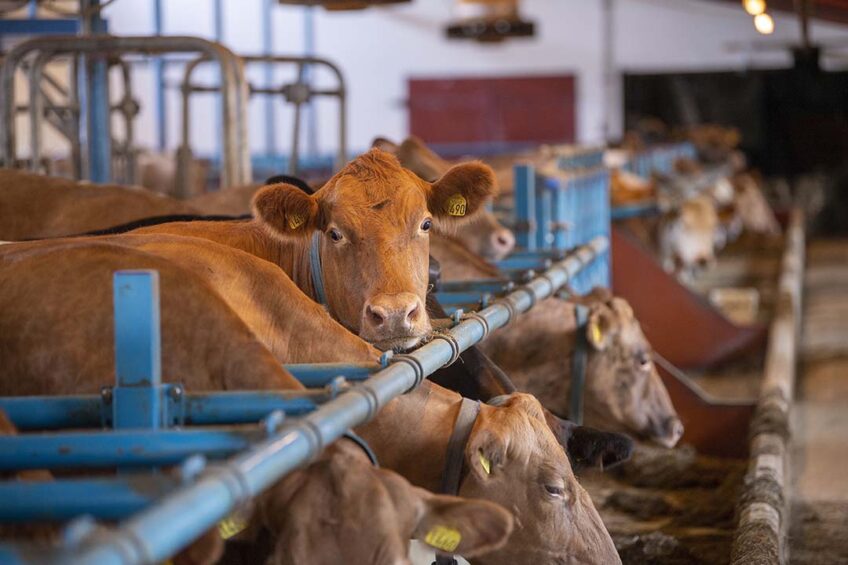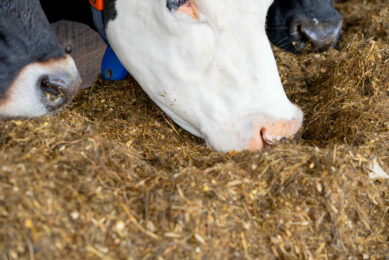What to consider to improve a dairy cow’s silage intake

This article examines some of the nutrition, disease and production problems associated with silage feeding. The strategies to be adopted for improved utilisation of the silage are also discussed.
The intake of silage dry matter is usually lower than that of the corresponding fresh crop (i.e., silage intake is about 27% less than intake of the same forage fed without ensiling). The presence of fermentation end-products, such as organic acids, ammonia and amides, may limit the intake of silage due to reduced palatability and the inhibition of rumen motility.
Wilting is the primary way of increasing silage intake through increasing dry matter content and, hence, improving the crop ensilability. Other measures include:
Enhancing silage fermentation by inoculation and enzymes;
Using a buffering material such as sodium bicarbonate with corn, sorghum or wheat silages may be beneficial in maintaining normal pH in the rumen, hence stimulating intake and digestibility;
Feeding cattle at least twice daily. At each feeding, cattle with empty or near empty bunks should be fed first, and the remainder fed in an organised pattern. This should minimise deterioration losses of silage resulting from the accumulation of feed in the bunk, and hence improve its intake and digestibility; and
Proper timing of silage feeding to help maintain higher intake. That is, on hot days, silage should be fed in late evening, night and early morning. In cold weather, the primary period of consumption should be mid-morning to late afternoon.
Effects on milk production
The large amounts of alcohol produced during silage fermentation, particularly in the direct-cut silages, may negatively effect milk taste and flavour. These alcohols are transferred to the milk system after being absorbed from the gastrointestinal tract and/or inhaled through the respiratory system during feeding. Therefore, the direct-cut silages should be fed at least 2-4 hours before milking to allow for a complete withdrawal of the alcohol from the blood via both the digestive and respiratory systems. Also, adequate ventilation should be provided in the barn to eliminate much of the alcohol present in the silage.
In some reports, it has been maintained that animals fed on silage were more prone to weight loss during transportation, and also had darker carcasses and lower killing-out percentages compared to those fed on fresh feed materials. Keeping this in mind, definite recommendations could then be made for better meat production.
Mineral deficiency
With some silages, particularly those made from grass, there is a frequent occurrence of copper and cobalt deficiencies in animals. The mineral problem may not be attributed solely to the fermentation process per se, but may be related to other factors as well.
Generally, minerals and other nutrient densities change as plant growth advances. This happens to a varying extent depending largely on the species of forage being used for feeding. Brome grass and Sudan grass, for example, retain their nutritive value and palatability over much longer periods than other grass species such as orchard grass or red canary grass, which are readily eaten by stock only when young. Change of vegetation structure could, therefore, provide a solution for nutritional problems associated with nutrients needed to meet a specific requirement.
Efforts should also be made to avoid contamination of the pre-ensiled material with soil at harvest through the use of proper harvest machinery. Recent work with copper, for example, has shown that diets containing 100 g soil per kg reduce the availability of the mineral by more than 50% compared with diets containing no soil. This may be attributed either to the occlusion of copper by soil particles within the alimentary tract of the animal or to the presence of molybdenum in the soil material, which adversely affects the absorption and utilisation of copper.
Silage and metabolic disorders
Various digestive and metabolic problems – including diarrhoea, enteritis, loss of appetite and ketosis – have been observed with animals fed on silages undergoing aerobic deterioration or clostridia activities. Also, with silages having large amounts of non-protein nitrogen formed during fermentation, there is often an increased level of blood ammonia in animals, which adversely affects the acid-base balance in their bodies. This is particularly true in animals with viral or parasitic problems in their liver, which makes them unable to dispose of the surplus ammonia from the body through catabolism. In these cases, such poorly preserved silages should be withdrawn from feeding programmes or at least be fed in very restricted amounts.
Poisoning
Feeding of grass silage contaminated with plant species such as ragwort (Senecio jacobaeu) may result in fatal poisoning characterised by cirrhosis of the liver, inflammation of the fourth stomach and other lesions. Cattle are especially susceptible to ragwort poisoning, which often leads to death 2-4 months after the last mouthful.
In areas where crops are harvested in wet or rainy weather, the ensiled crops usually undergo self-heating and mould damage. Mouldy silages contain 2 types of bacteria, namely Micropolyspora faeni and Thermoactinomyces vulgaris, with certain types of moulds called Aspergillus. These species can give rise to farmer’s lung disease, characterised by faulty gas exchange and respiratory distress.
With silages made from unconventional sources such as poultry litter, copper poisoning is likely to occur, because of the higher copper content of the litter material relative to the daily requirements of 150 ppm for cattle and 60 ppm for sheep. The condition is characterised by an enlarged liver, kidney and spleen, and associated with symptoms such as enteritis, diarrhoea, loss of appetite and depression. Such problems can be alleviated by feeding the litter silage in a restricted amount not exceeding 20% of the total diet for a period not longer than 60 days.
Bull feeding on silage
Due to the juicy nature of silage, especially when made from direct-cut crops, it is not recommended to use it in feeding bulls intended for breeding, as this leads to the abdomen expanding and increasing its size significantly, which in turn hinders the successful mating process and hence reduces reproductive efficiency. In this case, bulls should be fed diets consisting of 1 kg of hay and 0.5 kg of concentrates (12% protein) for every 100 kg of body weight. However, if such types of silage are to be fed, this should be done for limited periods and in small amounts, with the rest of the nutritional requirements met by concentrate feeds.
Join 13,000+ subscribers
Subscribe to our newsletter to stay updated about all the need-to-know content in the dairy sector, two times a week.










